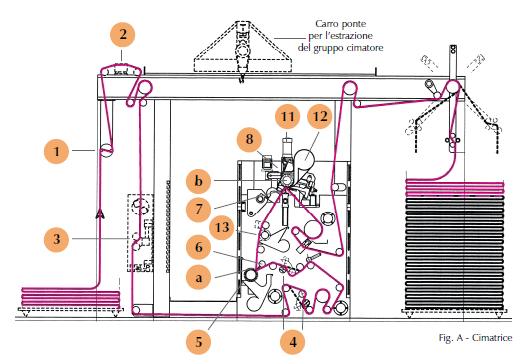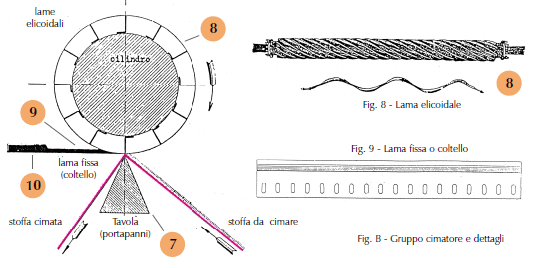© 2025 All rights reserved
Project by UsedTextilemachines.eu
Don't have an account yet? Sign in
Do you already have an account? Go to login Click here
Don't have an account yet? Sign in
Do you already have an account? Go to login Click here
Looking for the best opportunities to satisfy the customer:
Mobile Phone : +393319020189
Orari di lavoro : 09.30 / 12.30 - 16.00/18.00 Dal Lunedi' al Venerdi'.
Shearing is a process that involves cutting and homogenizing the surface pile of the fabric.
at a certain height. It is normally carried out in dry conditions and on almost all fabrics. Its
intensity varies from complete cutting of the superficial filaments to a simple trimming of the
their extremities.

The fabric passes in succession, through a cloth tensioner (see figure A, point 1), a metal detector
(fig. A, 2) and a piece centering device (fig. A, 3), driven by cylinders, some in neutral and others controlled. Two
spreading cylinders (fig. A, 4), perfectly stretch the pieces and avoid creases and swelling
before logging in
at the velvetization point (fig. A, a), where they are found
a cylindrical brush (fig. A, 5) with adjustable speed, which straightens the hair with steel tips
flexible, and
a movable wedge-shaped bar (fig. A, 6), which controls the approach of the fabric to the brush and to the cutting point (fig. A, b) where
a metal cloth holder (figs. A and B, 7), also wedge-shaped, keeps the fabric taut close to the group
shear, whose adjustable distance from the fabric determines the length of the hair.

The trimming group (fig. B), which is the most important part of the trimmer, consists of:
a rotating trimming cylinder (figs. A and B, 8 and fig. 8, detail), called a male, which depending on
of its diameter, it can accommodate from 16 to 32 helical blades of tempered steel placed on it
it screws;
an adjustable blade, called a knife (fig. B, 9 and fig. 9, detail), as long as the cylinder and locked
on the appropriate support (fig. B, 10).
The helical blades of the trimming cylinder, in contact with the underlying fixed blade (knife) create
a contrasting hair cutting point. When the trimming cylinder has completed its rotation, the blade
with a propeller that is fixed to it, it cuts the hair from one selvedge to the other. The helical blades can be
wrapped around the cylinder from right to left or vice versa. On multi-cylinder trimmer machines the direction of the helices
It is alternated to avoid deviations of the patch and to stabilize it in the center.
The fluff produced by trimming is removed by a vacuum cleaner (fig. A, 12).
A pneumatic lift (fig. A, 11) intervenes when the end seam passes.
In addition to the velvet machine and the trimming groups, the following are present:
brushes covered with horsehair (fig. A, 13); the one placed before the group is particularly important
shear which, acting on the reverse, removes any threads or fibres from the surface of the fabric;
feelers, which activate the lifting of the cylinders when seams pass in the wide range;
a thick felt soaked in a special oil that rests on the trimming cylinder, which keeps the helical threads and the fixed blade efficient for longer;
a series of drive cylinders, which carry the cloths to the lapper.
The trimming machine configurations can include: 1) single machine; 2) multiple machines in line; 3)
machines arranged on a chain of different processes (for example, raising and shearing).
The trimmer must:
start the machine, to check the direction of rotation and the contact of the brushes with the
tissue;
introduce the fabric, prepared according to the desired result and sewn into a ring;
lower the cylinder when the fabric arrives at the shearing unit, adjusting its height with the screws
register.
Then check:
•the uniformity of contact and the thickness between the cloth and the blade, stopping the machine and sliding
across the entire working height, paper thicknesses (normally made up of one or more cards).
•The felt placed over the cylinder, making sure it is soaked in the right amount of oil.
Start trimming and at each complete turn of the cloth
•compare the height of the topping with the sample,
•lower the cylinder, proceeding with successive cuts until the desired result is achieved.
More or less large holes resulting from knots that were not previously cut, shells or balls of fluff
formed on the back and not removed by the brush, especially on combed hair to be shaved
bottom.
Irregular shaving that occurs due to creases, overlapping of the fabric or lumps on the reverse.
They are the same causes of holes, but with a higher cylinder treatment.
Difference between center and selvedge, caused by preparation not well flat by the gauze or by the
coat rack.
Cut to length, for foreign material stuck on the hanger that lifts the fabric.
Hair cut not clean and uniform due to lack of group cutting.
By moving the fixed blade with respect to the cylinder, the cut can be increased but when the movement limit is reached,
the cut does not improve so the unit must be sent to the workshop to be ground and sharpened.
The trimmer, in addition to the pre-established tasks, must perceive "with the ear" sounds different from the normal one
trimming, since a few minutes' carelessness can split a patch.
The machine is equipped with safety sensors, but you need to be careful where you place them.
hands with disconnected sensors. Cleaning must always be carried out with the machine stopped and in any case
with great attention to the blades.
After the sale of the machinery, we also assist you in logistics and, if desired by the customer, we have technicians capable of reassembling and starting up the machinery.
© 2025 All rights reserved
Project by UsedTextilemachines.eu
| Cookie | Duration | Description |
|---|---|---|
| cookielawinfo-checkbox-analytics | 11 months | This cookie is set by the GDPR Cookie Consent plugin. The cookie is used to store the user consent for the cookies in the "Analytics" category. |
| cookielawinfo-checkbox-functional | 11 months | The cookie is set by GDPR cookie consent to record the user consent for the cookies in the category "Functional". |
| cookielawinfo-checkbox-necessary | 11 months | This cookie is set by the GDPR Cookie Consent plugin. The cookies is used to store the user consent for the cookies in the category "Necessary". |
| cookielawinfo-checkbox-others | 11 months | This cookie is set by the GDPR Cookie Consent plugin. The cookie is used to store the user consent for the cookies in the category "Other. |
| cookielawinfo-checkbox-performance | 11 months | This cookie is set by the GDPR Cookie Consent plugin. The cookie is used to store the user consent for the cookies in the "Performance" category. |
| viewed_cookie_policy | 11 months | The cookie is set by the GDPR Cookie Consent plugin and is used to store whether or not user has consented to the use of cookies. It does not store any personal data. |
Fill out the form to contact me